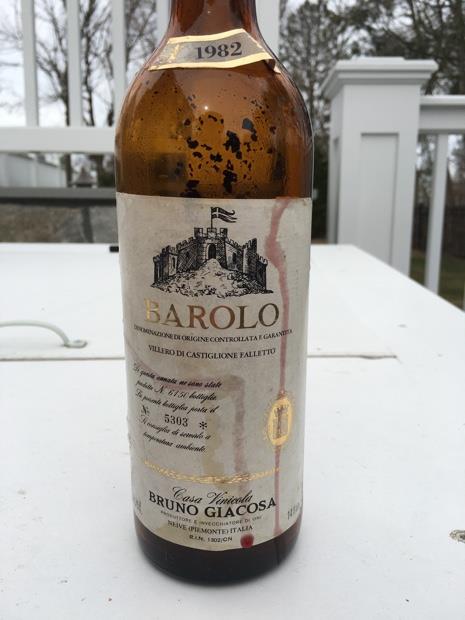
External search
Google (images)
Wine Advocate
Wine Spectator
Burghound
Wine-Searcher
Vintages
1996
1995
1993
1990
1989
1988
1987
1986
1985
1983
1982
1980
1979
1978
N.V.
From this producer
Show all wines
All tasting notes
|
| Drinking Windows and Values |
| Community Tasting History |
| Community Tasting Notes (average 93 pts. and median of 93 pts. in 1 note) - hiding notes with no text | | | Tasted by Burgundy Al on 10/7/2014 & rated 93 points: (Mostly) Barolo Dinner (Osteria Langhe - Chicago IL): Open 4 hours before serving. Exciting floral start with mature red berry and cherry on nose and palate. Spicebox includes black pepper and tarragon with outstanding minerality. Very good balance and textures. Very elegant and sophisticated. I was told 1983 was a mediocre vintage (at best), but this was easily in my "top 5" tonight and 2 people thought it in their "top 2." A big contrast to the same wine from 1988 in the next glass, which was more backward and brooding. (2735 views) |
| Bruno Giacosa Producer website | Importer website
IMPORTANT: Please read this guide to ensure that you are cataloging your wine correctly.
Links: Ken Vastola's fabulous guide to Giacosa labels
WINES OF THE WINERY "AZIENDA AGRICOLA FALLETTO"The grapes are grown in the winery’s own vineyards and vinified in their cellars. These wines are sold with a label bearing the wording: "Azienda Agricola FALLETTO"– di Bruno GiacosaNebbioloNebbiolo is a red grape indigenous to the Piedmont region of Italy in the Northwest. The grape can also be found in other parts of the world, though they are not as respected.
Nebbiolo is often considered the "king of red wines," as it is the grape of the famed wines of Barolo DOCG, Barbaresco DOCG, and Roero DOCG. It is known for high tannins and acidity, but with a distinct finesse. When grown on clay, Nebbiolo can be very powerful, tannic, and require long aging periods to reach its full potential. When grown on sand, the grape exhibits a more approachable body with more elegant fruit and less tannins, but still has high aging potential.
"Nebbiolo" is named for the Italian word, "nebbia", which means "fog", in Italian and rightfully so since there is generally a lot of fog in the foothills of Piedmont during harvest.
Nebbiolo is a late-ripening variety that does best in a continental climate that boasts moderate summers and long autumns. In Piedmont, Nebbiolo is normally harvested in October.
More links:
Varietal character (Appellation America) | Nebbiolo on CellarTrackerItaly Italian Wines (ItalianMade.com, The Italian Trade Commission) | Italian Wine Guide on the WineDoctorPiedmont Vignaioli Piemontesi (Italian only)
On weinlagen-infoLanghe Consorzio di Tutela Barolo Barbaresco Alba Langhe e Roero | Union of Producers of Albese Wines (Albeisa)BaroloRegional History:
The wines of Piedmont are noted as far back as Pliny's Natural History. Due to geographic and political isolation, Piedmont was without a natural port for most of its history, which made exportation treacherous and expensive. This left the Piedmontese with little incentive to expand production. Sixteenth-century records show a mere 14% of the Bassa Langa under vine -- most of that low-lying and farmed polyculturally. In the nineteenth century the Marchesa Falletti, a frenchwoman by birth, brought eonologist Louis Oudart from Champagne to create the first dry wines in Piemonte. Along with work in experimental vineyards at Castello Grinzane conducted by Camilo Cavour -- later Conte di Cavour, leader of the Risorgimento and first Prime Minister of Italy -- this was the birth of modern wine in the Piedmont. At the heart of the region and her reputation are Alba and the Langhe Hills. This series of weathered outcroppings south of the Tanaro River is of maritime origin and composed mainly of limestone, sand and clay, known as terra bianca. In these soils -located mainly around the towns of Barolo and Barbaresco -- the ancient allobrogica, now Nebbiolo, achieves its renowned fineness and power.
map of Barolo DOCG
An interesting thread on Traditional vs. Modern Barolo producers:
https://www.wineberserkers.com/forum/viewtopic.php?f=1&t=106291 |
|




